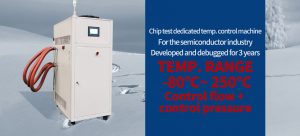The Phenomenon of Ice Jam in Low Temperature Chiller System
The phenomenon of ice jam in low temperature chiller system is mainly due to the excessive water in the refrigeration system. With the continuous circulation of refrigerants, the water in the refrigeration system gradually concentrates at the outlet of expansion valve. Because the outlet of expansion valve has the lowest temperature, the water turns into ice and the ice enlarges gradually. To a certain extent, the expansion valve will be completely blocked, resulting that the refrigerant can not be recycled, and the cold storage will not refrigerate.
The phenomenon of ice jam in low temperature chiller system is normal in the initial stage. There is frost in the evaporator, heat dissipation of the condenser, stable operation of the unit, clear and stable movement of refrigerant in the evaporator. With the formation of ice jam, the air flow is gradually weakened and intermittent. When the jam becomes serious, the sound of air flow completely disappears. The refrigerant cycle is interrupted. And the condenser is gradually cooled.
Because of the blockage, the exhaust pressure rises. The sound of the machine increases. There is no refrigerant flowing into the evaporator. The frost area decreases gradually. The temperature increases gradually, and the temperature of the expansion valve rises together, so the ice begins to melt. At this time, the refrigerant begins to recycle again. After a period of time, ice blockage occurs again, forming a periodic phenomenon of through-blockage.
Troubleshooting of Ice Block
The ice jam failure of low temperature chiller system is due to excessive moisture in the system, so the whole refrigeration system must be dried. There are two ways to deal with it:
1. Heat and dry the components of the refrigerant system in a drying box. Remove the compressor, condenser, evaporator, expansion valve and return pipe in the refrigerant system from the cold storage and put them into the drying box for heating and drying.
2. Remove the water content of each part of the refrigeration system by heating and secondary vacuum extraction.
Recommandations connexes
-
Instructions for component testing of chip inspection companies
1012With the continuous development of the component testing industry, chip testing companies have sprung up, and LNEYA has also introduced component testing equipment for chip testing. The test vector of the chip inspection company is stored in the v...
Voir les détails -
Semiconductor Temperature Forcing System Thermal Flow Hood for DUT Testing
893The semiconductor temperature forced system (TFS), thermal flow meter and thermal flow hood are important equipment used to test the performance of semiconductor devices under different temperature conditions. These equipment are usually u...
Voir les détails -
High and low temperature circulation tank daily use instructions
1419During the operation of the high and low temperature circulation tank, some phenomena generated by the LNEYA protection device need to be observed. If some improper sounds and unexpected situations occur, we need to solve it in time. The high and ...
Voir les détails -
Application of crystallization technology of ultra-low temperature chiller in petroleum industry
927This article mainly introduces the application of the freezing technology crystallization technology of industrial refrigerators in the oil industry and the principle of freezing crystallization. At present, the separation method using freeze crys...
Voir les détails
 LNEYA Industrial Chillers Fabricant Fournisseur
LNEYA Industrial Chillers Fabricant Fournisseur












